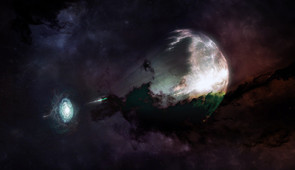
Explosive neutron star merger captured for first time in millimeter light
Flash is one of the most energetic short-duration gamma-ray bursts ever observed
- Link to: Northwestern Now Story
- Short-duration gamma-ray bursts only last a fraction of a second, making them difficult to detect
- Astrophysicists detected the burst with X-rays and then identified its location by studying the burst’s afterglow with millimeter light
- Researchers pinpointed the event to when the universe was just 40% of its current age
EVANSTON, Ill. — For the first time, scientists have recorded millimeter-wavelength light from a fiery explosion caused by the merger of a neutron star with another star.
Led by Northwestern University and Radboud University in the Netherlands, the team also confirmed this flash as one of the most energetic short-duration gamma-ray bursts (GRBs) ever observed, leaving behind one of the most luminous afterglows on record.
Astrophysicists made the discovery with the Atacama Large Millimeter/submillimeter Array (ALMA), an international observatory operated by the National Science Foundation’s National Radio Astronomy Observatory (NRAO). Located in the high-altitude Atacama Desert in Chile, the ALMA array comprises 66 radio telescopes, making it the largest radio telescope in the world.
“This short gamma-ray burst was the first time we tried to observe such an event with ALMA,” said Northwestern’s Wen-fai Fong, principal investigator of the ALMA program. “Afterglows for short bursts are very difficult to come by, so it was spectacular to catch this event shining so brightly. After many years observing these bursts, this surprising discovery opens up a new area of study, as it motivates us to observe many more of these with ALMA and other telescope arrays in the future.”
The research will be published in an upcoming issue of the Astrophysical Journal Letters.
Fong is an assistant professor of physics and astronomy at Northwestern’s Weinberg College of Arts and Sciences and a key member of the Center for Interdisciplinary Exploration and Research in Astrophysics (CIERA). Northwestern coauthors include Alicia Rouco Escorial, Genevieve Schroeder, Jillian Rastinejad, Charles Kilpatrick, Kate Alexander and Anya Nugent.
Extreme energy
The brightest and most energetic explosions in the universe, GRBs are capable of emitting more energy in a matter of seconds than our sun will emit during its entire lifetime. In the new study, astrophysicists examined GRB 211106A, which belongs to a GRB subclass known as short-duration gamma ray bursts. Responsible for creating the heaviest elements in the universe, such as platinum and gold, these explosions result from a catastrophic merger of binary star systems containing at least one neutron star.
“These mergers are excellent sources of gravitational waves, making them premier multi-messenger cosmic sources that can be observed with gravitational waves and light,” Fong said. “While this GRB was out of the range of current gravitational wave observatories, we were still able to mobilize several observatories to capture its light in the millimeter, radio and X-ray wavelengths.”
“These mergers occur because of gravitational wave radiation that removes energy from the orbit of the binary stars, causing the stars to spiral in toward each other,” said the study’s lead author Tanmoy Laskar, an Excellence Fellow at Radboud University. “The resulting explosion is accompanied by jets moving at close to the speed of light. When one of these jets is pointed at Earth, we observe a short pulse of gamma-ray radiation or a short-duration GRB.”
The importance of millimeters
A short-duration GRB usually lasts only a few tenths of a second. After it fades, scientists look for an afterglow, an emission of light caused by the interaction of the jets with surrounding gas. Even still, short-duration GRBs are difficult to detect. Only half a dozen short-duration GRBs have been detected at radio wavelengths, and, until now, none had been detected in millimeter wavelengths.
“Millimeter wavelengths can tell us about the density of the environment around the GRB,” said Schroeder, study coauthor and graduate student in Fong’s research group. “And, when combined with the X-rays, they can tell us about the true energy of the explosion. Because emission at millimeter wavelengths can be detected for a longer time than in X-rays, the millimeter emission also can be used to determine the width of the GRB jet.”
“What makes GRB 211106A so special is it’s not only the first short-duration GRB that we detected in this wavelength, but also, thanks to the millimeter and radio detection, we could measure the opening angle of the jet,” added Rouco Escorial, study coauthor and postdoctoral fellow in CIERA. “The millimeter and radio bands provided us with information we needed to measure the jet opening angle. This is essential to infer the real rates of short GRBs in our universe and to compare them with the rates of binary neutron star or neutron star and black hole mergers.”
Because GRB 211106A occurred when the universe was just 40% of its current age, the light was particularly faint. Although NASA’s Neil Gehrels Swift Observatory detected the explosion with X-ray observations, the host galaxy was undetectable at that wavelength, leaving scientists unable to determine exactly where the explosion was coming from. NASA’s Hubble Space Telescope detected optical and infrared light from the host galaxy, while ALMA detected millimeter light from the afterglow. Each wavelength added a new dimension to scientists’ understanding of the GRB, and millimeter, in particular, was critical to uncovering the truth about the burst.
“The Hubble observations revealed an unchanging field of galaxies,” Laskar said. “ALMA’s unparalleled sensitivity allowed us to pinpoint the location of the GRB in that field with more precision, and it turned out to be in another faint galaxy, which is further away. That, in turn, means that this short-duration gamma-ray burst is even more powerful than we first thought, making it one of the most luminous and energetic on record.”
“ALMA shatters the playing field in terms of its capabilities at millimeter wavelengths and has enabled us to see the faint, dynamic universe in this type of light for the first time,” Fong said. “After a decade of observing short GRBs, it is truly amazing to witness the power of using these new technologies to unwrap surprise gifts from the universe.”
The study, “The first short GRB millimeter afterglow: The wide-angled jet of the extremely energetic SGRB 211106A,” was supported by the National Science Foundation (award numbers AST-1814782, AST-1909358 and AST-2047919), the David and Lucile Packard Foundation and NASA (award numbers NNM11AA01A and GO1-22059X).
Multimedia Downloads
Gamma-ray burst image

Credit: ALMA (ESO/NAOJ/NRAO), M. Weiss (NRAO/AUI/NSF)
Interview the Experts
